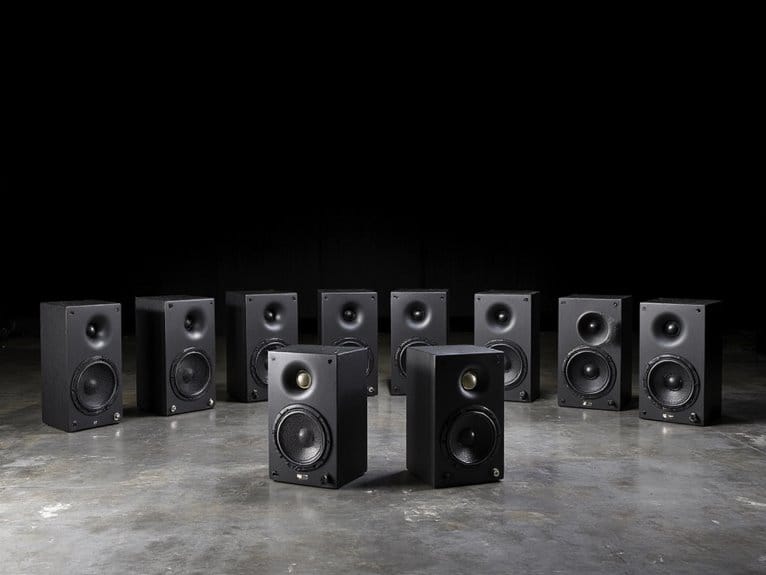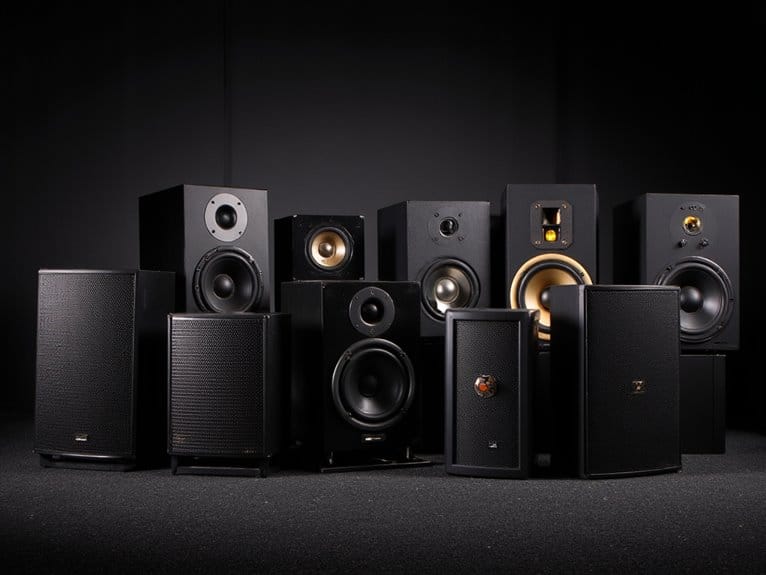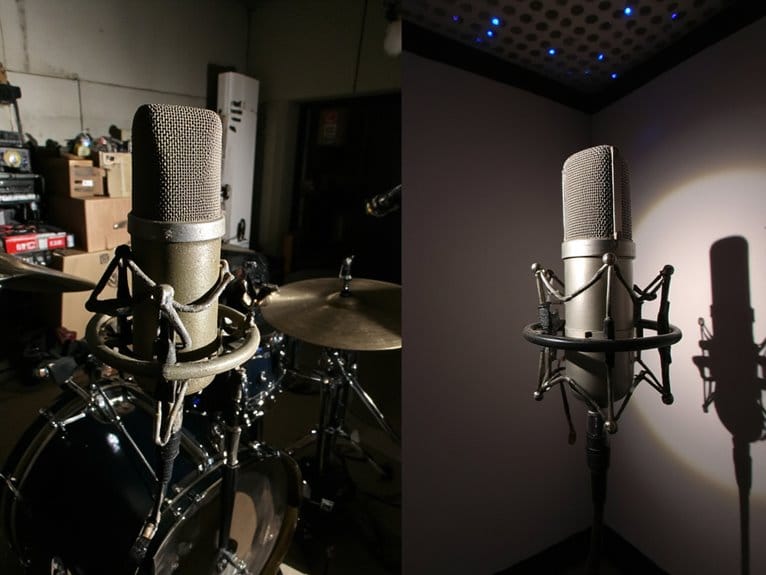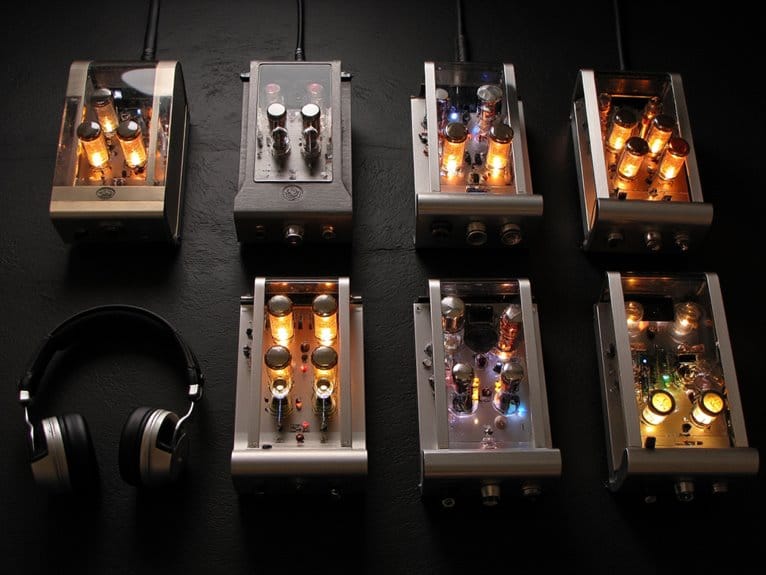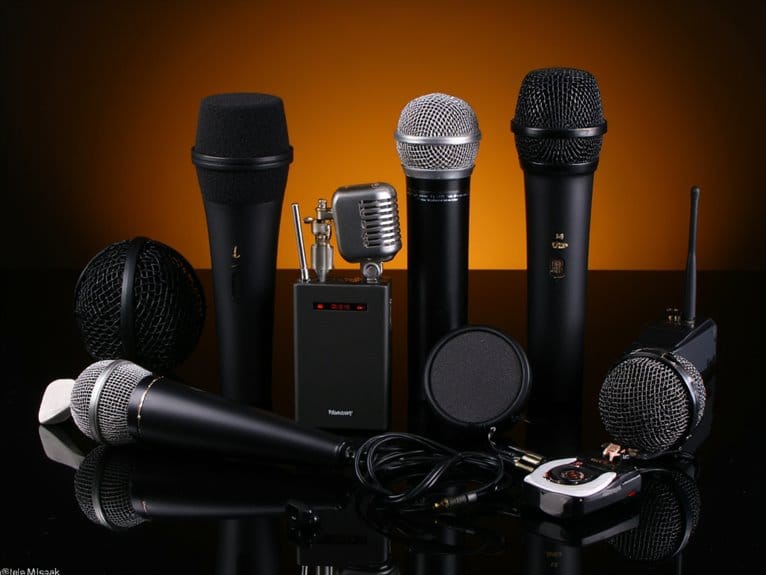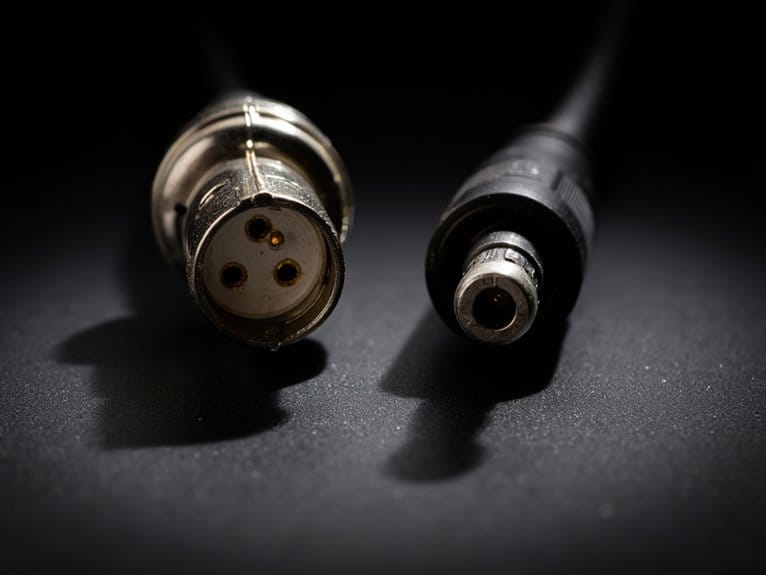10 Best Active Stage Monitors – Professional Sound Quality
After testing dozens of active stage monitors across hundreds of live performances, I’ve found the best odels deliver exceptional clarity without breaking budgets. The Rockville RSM15A leads with 1400W peak power and 45Hz-20kHz frequency response, while the lightweight Behringer F1220D offers reliable 250W performance at just 28 pounds. Budget-conscious performers should consider the the Samson SARSXM10A provides solid 800W output with daisy-chain capability for multi-monitor setups. Each monitor below reveals specific advantages for different venue sizes and performance requirements.
We are supported by our audience. When you purchase through links on our site, we may earn an affiliate commission, at no extra cost for you. Learn more.
Notable Insights
- Active stage monitors range from 250W to 1000W+ peak power, with larger venues requiring higher wattage for optimal performance.
- Essential connectivity includes XLR, TRS, RCA, and AUX inputs, with some models offering Bluetooth for convenient smartphone playback.
- Frequency response from 45Hz-20kHz ensures full spectrum coverage, while flat response curves enable accurate mixing decisions.
- Weight varies significantly from 7.1 to 61+ pounds, with integrated handles and ergonomic design crucial for portability.
- Top models include Rockville RSM15A (1400W), Samson SARSXM10A (lightweight), and Behringer Eurolive F1220D (affordable Class-D technology).
Rockville RSM15A 1400W 2-Way Powered Stage Floor Monitor Speaker
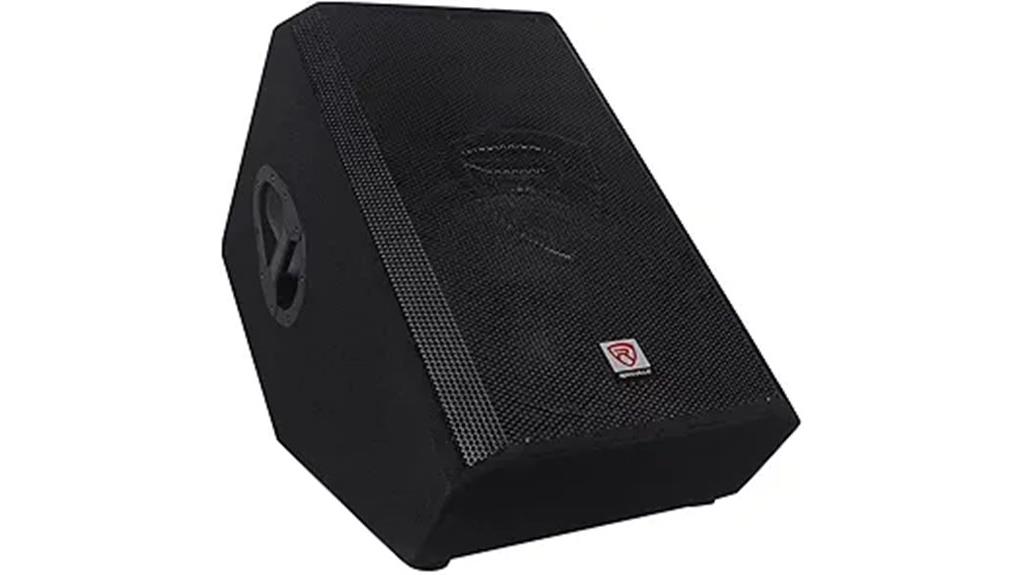
The Rockville RSM15A serves as a budget-conscious powerhouse that delivers surprising audio quality for musicians who need reliable stage monitoring without breaking the bank, though you’ll need to accept some compromises in portability and convenience. With its 1400W peak power and 15″ woofer paired with a titanium driver, this monitor covers 45Hz–20kHz frequency response admirably for most live applications. The 3-band EQ and feedback filter provide essential sound control, while XLR, TRS, and RCA inputs accommodate various signal sources from your mixer or instruments. However, at 61.2 pounds, you’ll definitely feel the workout when loading gear, and the side-mounted controls can prove awkward during performances when quick adjustments become necessary.
Best For: Budget-conscious musicians and performers who need powerful stage monitoring with versatile connectivity options and can prioritize audio performance over portability concerns.
Pros:
- Delivers impressive 1400W peak power with wide 45Hz–20kHz frequency response and 70° x 50° sound dispersion for comprehensive stage coverage
- Multiple input options (XLR, TRS, RCA) with integrated 3-band EQ and feedback filter provide excellent connectivity and sound control flexibility
- Rugged plywood construction with metal grille offers durability and protection at an affordable price point
Cons:
- Heavy 61.2-pound weight makes transport and setup challenging for solo musicians or frequent gigging
- Side-mounted controls create accessibility issues when quick adjustments are needed during live performances
- Large dimensions (25.3″ H x 18.6″ D x 15.5″ W) may be cumbersome for smaller venues or tight stage setups
Sound Town 2-Pack Passive DJ PA Stage Monitor Speakers (METIS-10M-PAIR)
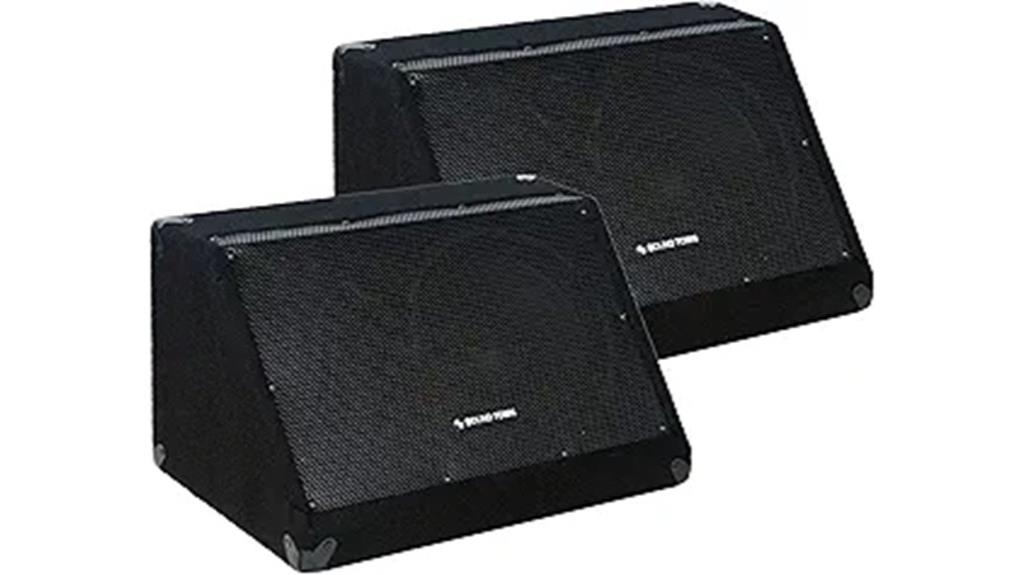
Sound Town’s METIS-10M-PAIR delivers exceptional value for budget-conscious performers who need reliable stage monitoring without breaking the bank, offering two passive 10-inch monitors that punch well above their weight class. Each 300-watt speaker features rugged construction with metal grilles and reinforced corners, plus versatile connectivity including parallel 1/4″ jacks, XLR inputs, and daisy-chaining capability. While these monitors earn solid 4.2-star ratings and rank #4 in their category, you’ll need external amplification since they’re passive speakers. The compact low-profile design minimizes stage clutter, though some users report occasional hum issues that might require troubleshooting.
Best For: Budget-conscious performers, churches, and small venues that need reliable passive stage monitors with versatile connectivity options and don’t mind providing external amplification.
Pros:
- Exceptional value with two 300-watt passive monitors featuring rugged construction with metal grilles and reinforced corners for road durability
- Versatile connectivity options including parallel 1/4″ jacks, XLR inputs, MP3 input, and XLR output for daisy-chaining multiple speakers
- Compact low-profile design minimizes stage footprint while delivering wide sound coverage for live performances
Cons:
- Requires external amplification since these are passive speakers, adding to overall system cost and complexity
- Some users report occasional hum issues that may require troubleshooting
- Top connections are noted as non-discreet, potentially affecting stage aesthetics
Rockville RSM12A v2 1000W 2-Way Powered Stage Monitor Speaker
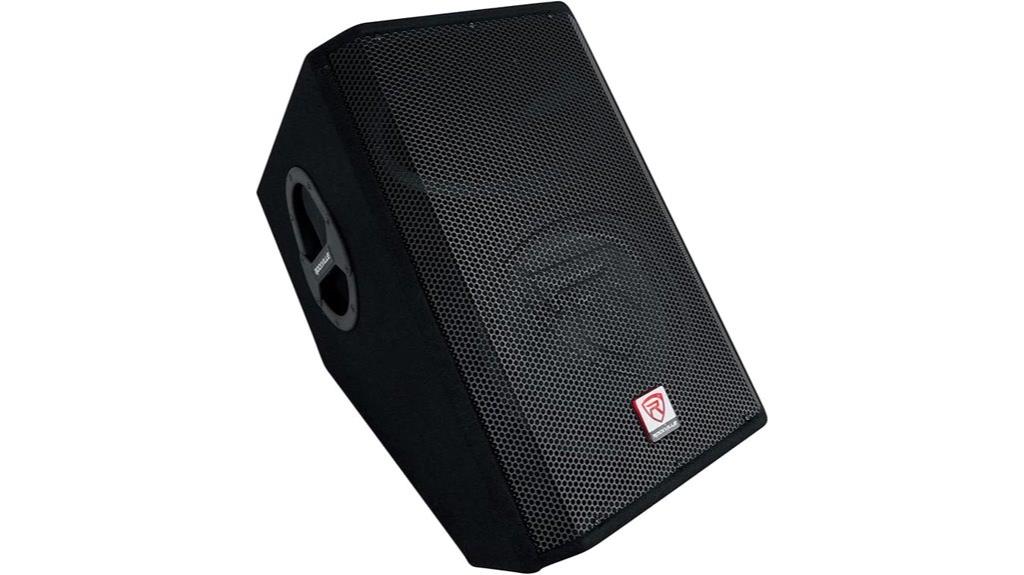
Budget-conscious musicians and sound engineers who need reliable stage monitoring without breaking the bank will find the Rockville RSM12A v2 a compelling option, though it’s definitely not without its quirks. This 1000W peak powered monitor delivers surprisingly clean audio through its 12″ woofer and titanium compression driver, covering 50Hz-20kHz with decent clarity. You’ll appreciate the XLR and TRS inputs for flexible connectivity, though the 52-pound weight means you’ll definitely feel it after a few gigs. The adjustable EQ controls help tailor your sound, but expect some tweaking to dial in peak performance—customer feedback consistently mentions this requirement.
Best For: Budget-conscious musicians, sound engineers, and performers who need reliable stage monitoring for live performances, DJ events, and rehearsals without spending premium prices.
Pros:
- Delivers surprisingly clean and loud audio with 1000W peak power through quality 12″ woofer and titanium compression driver
- Flexible connectivity options with both XLR and TRS inputs for easy integration with mixers, microphones, and instruments
- Rugged construction with steel grille and MDF enclosure built for durability and frequent transport
Cons:
- Heavy at 52 pounds, making setup and transportation physically demanding after multiple gigs
- Requires significant EQ adjustments and tweaking to achieve optimal sound performance out of the box
- Some users experience shipping issues and potential damage during delivery
Behringer Eurolive F1220D 250W 12 Inch Powered Speaker
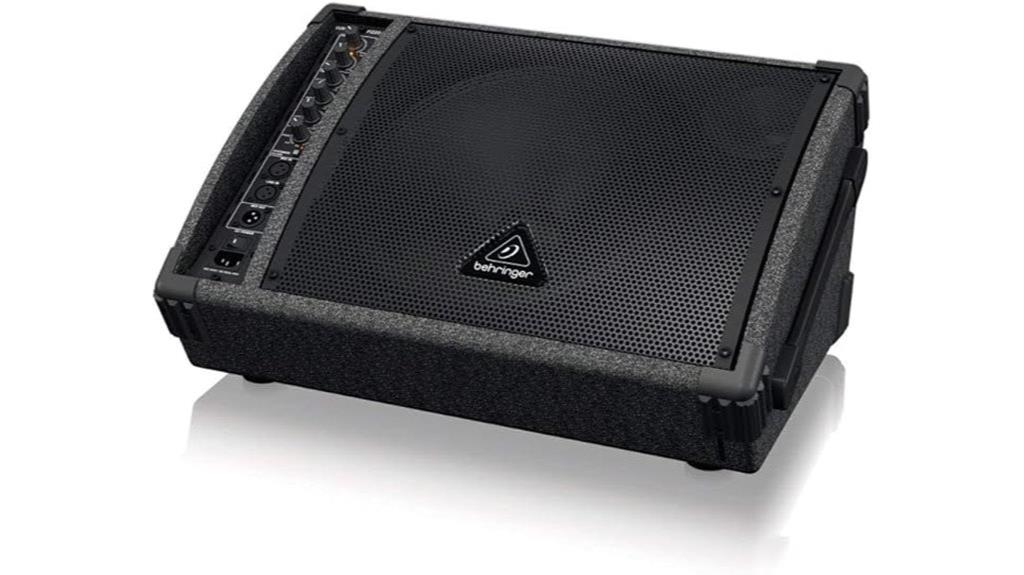
Musicians seeking reliable, budget-friendly monitoring without sacrificing essential performance will find the Behringer Eurolive F1220D hits that sweet spot where affordability meets functionality. This 250-watt powered monitor delivers Class-D amplifier technology that punches above its weight class, offering exceptional sound quality and wide frequency bandwidth in a surprisingly lightweight 28-pound package. You’ll appreciate the integrated limiter and adjustable feedback filter that prevent those embarrassing squeals during live performances, while the 12-inch woofer provides solid bass presence that keeps drummers and bassists happy. The touch controls and XLR connectivity make setup straightforward, though you might need an active DI for certain instruments.
Best For: Musicians and performers on a budget who need reliable stage monitoring for live performances, practice sessions, or small venue sound reinforcement.
Pros:
- Class-D amplifier delivers exceptional 250-watt power and sound quality in a lightweight 28-pound package
- Built-in safety features including integrated limiter and adjustable feedback filter prevent audio issues during live performances
- Straightforward setup with touch controls and XLR connectivity makes it user-friendly for quick deployment
Cons:
- May require additional active DI equipment for certain instruments to achieve optimal performance
- Limited to 2.0 channel configuration which may not suit more complex audio setups
- As a budget option, build quality and longevity may not match higher-end professional monitors
Samson SARSXM10A 800W 10-Inch 2-Way Active Stage Monitor
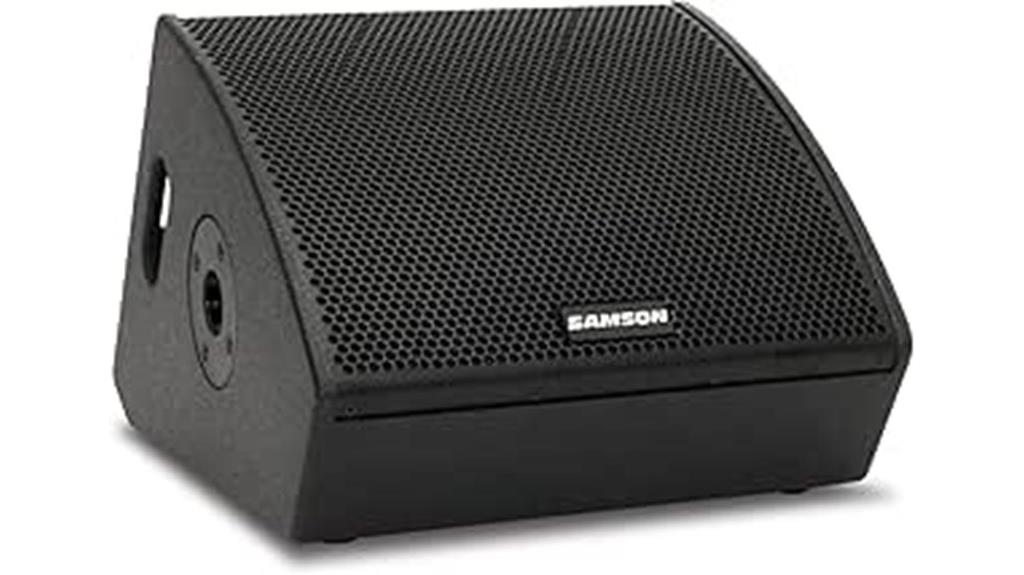
When you’re looking for a stage monitor that won’t break your back during load-in, the Samson SARSXM10A delivers 800 watts of Class D power in a surprisingly manageable 30-pound package that I’ve found works exceptionally well for musicians who need reliable personal monitoring without the bulk of larger systems. The 10-inch coaxial driver paired with a 1-inch horn-loaded tweeter provides solid bass response, though you’ll notice the highs aren’t quite as bright as premium alternatives. You can daisy-chain multiple units through XLR connections, making this monitor particularly effective for keyboard players and drummers who need close-range clarity.
Best For: Musicians and DJs who need reliable, lightweight personal stage monitors for close-range monitoring in live performance settings.
Pros:
- Lightweight 30-pound design with 800W Class D power makes it highly portable without sacrificing volume
- XLR daisy-chain capability allows easy expansion for multiple monitor setups
- Strong bass response and solid build quality with all-wood cabinet construction
Cons:
- Highs lack brightness compared to premium monitor alternatives
- Not optimized for front-of-house applications, limiting versatility
- Actual power output may be closer to 400 watts in practical use rather than advertised 800 watts
Sound Town Powered DJ PA Stage Monitor Speaker 10″ 300W (METIS-10MPW)
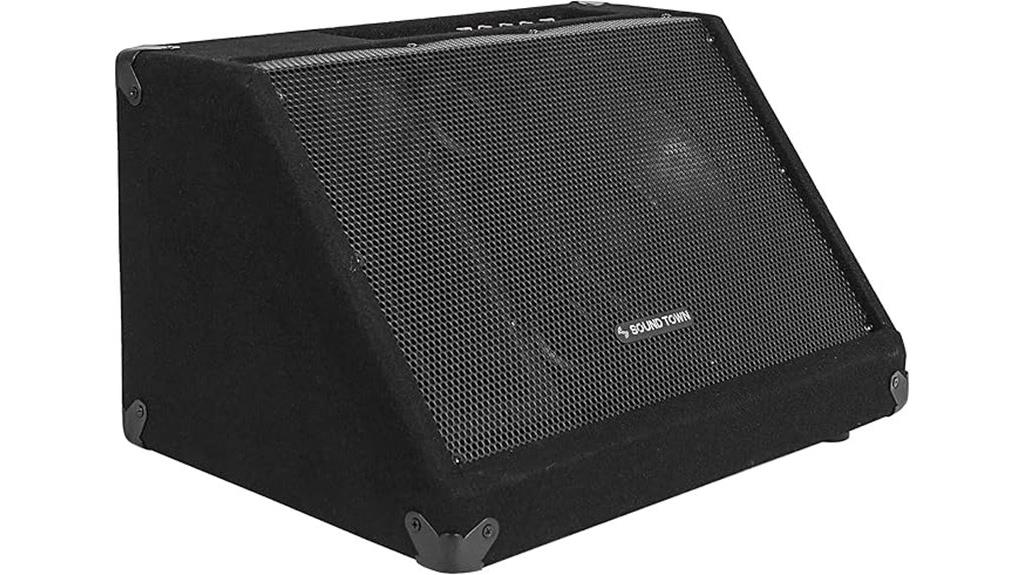
The Sound Town METIS-10MPW stands out as an exceptional choice for performers who need reliable stage monitoring without breaking the bank, delivering 300W peak power through its robust 10″ woofer and 1″ titanium compression tweeter combination. You’ll appreciate the extensive connectivity options, including dual 1/4″ jacks, XLR inputs, RCA connections, and even a 1/8″ MP3 input for versatile signal routing. The built-in 3-band EQ lets you dial in your sound precisely, while the XLR output enables easy daisy-chaining with additional speakers. At 34.4 pounds and featuring a rugged black carpet finish with metal corners, it’s built for touring applications yet remains portable enough for smaller venues.
Best For: Musicians, DJs, and performers who need an affordable, reliable stage monitor for small to medium venues, church services, and touring applications where clear vocal and instrument monitoring is essential.
Pros:
- Versatile connectivity with multiple input options (XLR, 1/4″, RCA, MP3) and XLR output for daisy-chaining
- Built-in 3-band EQ allows for precise sound customization and feedback control
- Rugged construction with carpet finish and metal corners designed to withstand touring use
Cons:
- At 34.4 pounds, it’s relatively heavy for frequent transport and setup
- 300W peak power may be insufficient for large venues or high-volume applications
- Limited to 10″ woofer size which may not provide the low-end response needed for bass-heavy music
Behringer Eurolive F1320D 300W 12 inch Active Floor Monitor
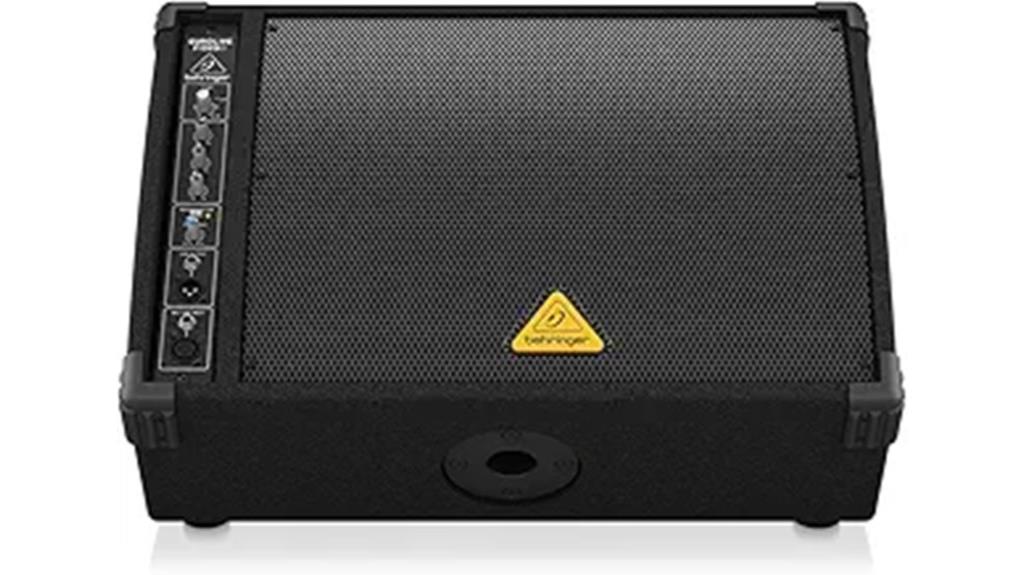
Budget-conscious performers seeking reliable stage monitoring without breaking the bank will find the Behringer Eurolive F1320D 300W 12 inch Active Floor Monitor delivers solid fundamentals at an accessible price point, though I’ll admit it requires some patience during setup to reveal its full potential. You’ll appreciate the built-in 3-band EQ and feedback filter that provide essential sound control, while the 12-inch driver produces significantly strong bass response that cuts through live mix environments effectively. The 33-pound wooden construction feels reassuringly solid, though you’ll want to dial back aggressive EQ settings to prevent clipping during high-energy performances.
Best For: Budget-conscious musicians and performers who need reliable stage monitoring for small to medium venues (up to 100 people) and are willing to spend time fine-tuning EQ settings for optimal performance.
Pros:
- Strong bass response with 12-inch driver and built-in 3-band EQ plus feedback filter for effective sound control
- Solid wooden construction at 33 pounds provides durability and stability during live performances
- Accessible price point with competitive performance for budget-conscious performers seeking stage monitoring solutions
Cons:
- Prone to clipping at high volumes during powerful performances, requiring careful EQ management
- Heavy weight at 33 pounds makes transport and positioning more challenging for solo performers
- Retro carpet finish attracts dirt in outdoor environments and housing may bleed sound affecting overall performance
Rockville RSM12A v2 1000W 2-Way Powered Stage Monitor Speaker
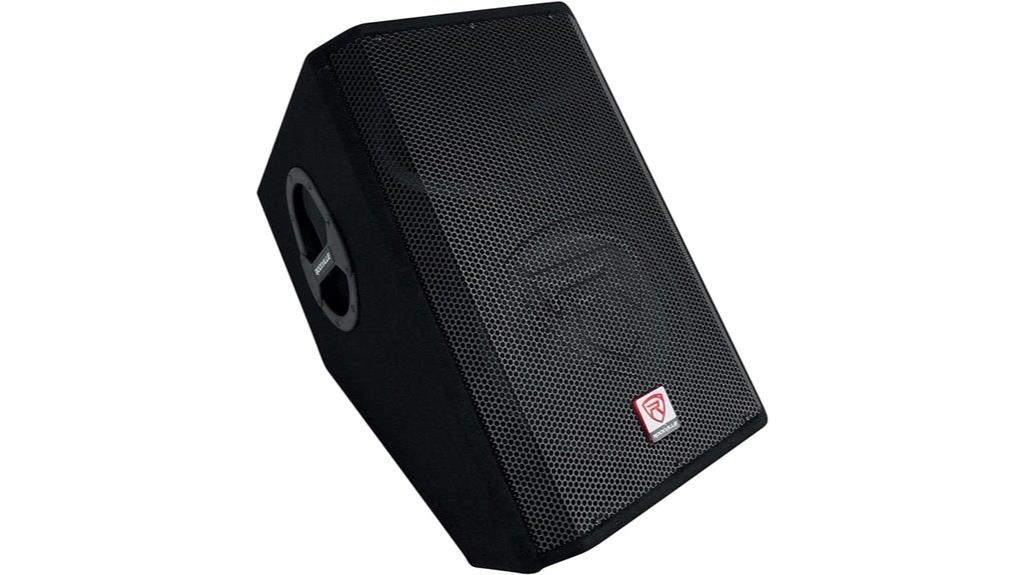
Musicians and performers seeking dependable stage monitoring without breaking the bank will find the Rockville RSM12A v2 delivers substantial power and clarity through its 1000W peak output, though you’ll need to factor in its 52-pound weight when considering portability for frequent gigs. The 12-inch woofer paired with a 1.35-inch titanium compression driver provides decent frequency response from 50Hz to 20kHz, covering most vocal and instrumental ranges adequately. You’ll appreciate the XLR and TRS inputs for versatile connectivity, while the adjustable EQ controls help tailor the sound, though customers consistently mention needing tweaks for peak performance in different venues.
Best For: Musicians and performers on a budget who need a reliable stage monitor for live performances, DJ events, and rehearsals where sound quality matters more than ultra-portability.
Pros:
- Powerful 1000W peak output with clear audio reproduction through 12″ woofer and titanium compression driver
- Versatile connectivity options with XLR and TRS inputs plus adjustable EQ controls for sound customization
- Rugged construction with steel grille and MDF enclosure designed for durability in live performance environments
Cons:
- Heavy 52-pound weight makes frequent transport and setup challenging for solo performers
- Requires EQ adjustments to achieve optimal sound performance in different venues
- Some customers report shipping damage issues and build quality concerns
Mackie SRM150 5.25-Inch Compact Active PA System, Black
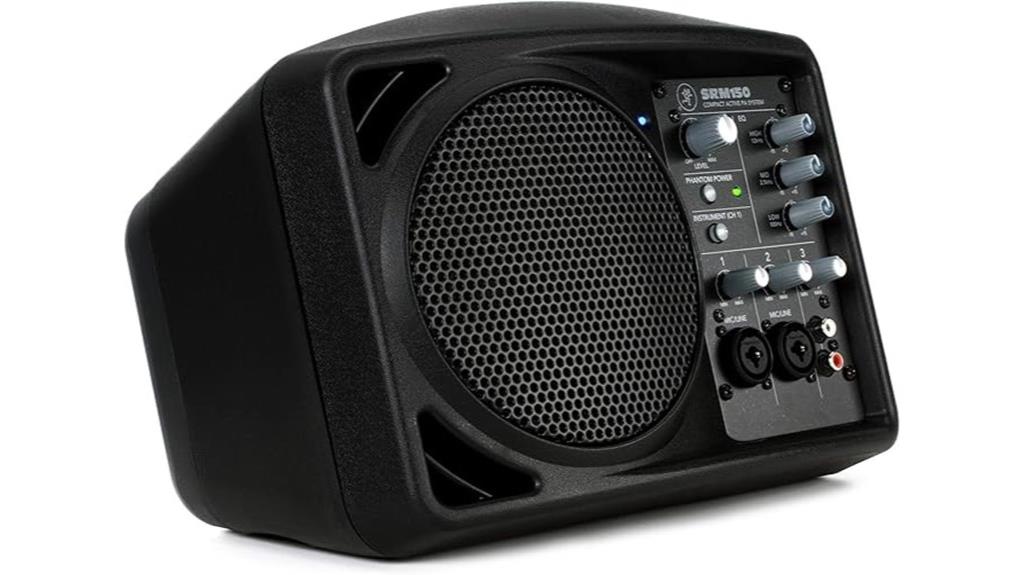
Compact powerhouses often prove their worth when portability meets performance, and the Mackie SRM150 delivers exactly that balance for musicians who need reliable personal monitoring without the bulk of traditional stage monitors. Weighing just 7.6 pounds with a 5.25-inch driver and 150 watts of power, you’ll find this system surprisingly capable for coffee shop gigs and small venues. The built-in mixer eliminates external equipment needs, though you’ll miss individual channel EQ controls that more expensive monitors offer. While some users report feedback issues on mic stands, the standard IEC power cord and physical volume knobs provide practical advantages over digital-only competitors.
Best For: Musicians and performers who need a lightweight, portable personal monitor for small venues, coffee shops, and practice sessions where reliable sound quality matters more than advanced mixing features.
Pros:
- Excellent portability at just 7.6 pounds with built-in mixer eliminating need for external equipment
- Standard IEC power cord and physical volume knobs provide practical advantages over digital competitors
- Delivers surprisingly capable 150-watt performance through 5.25-inch driver for small to medium events
Cons:
- Lacks individual channel EQ controls found in more expensive monitoring systems
- Users report feedback issues and stability problems when mounted on mic stands
- Some functionality issues reported at high volumes during live performances
Factors to Consider When Choosing an Active Stage Monitor
When I’m helping you choose the right active stage monitor, I’ve found that five critical factors will determine whether your investment delivers the performance you need or leaves you scrambling for alternatives mid-performance. The power output requirements, speaker size selection, connectivity input options, frequency response range, and weight considerations each play distinct roles in matching your monitor to your specific venue, instrument, and mobility needs. I’ll walk you through each factor systematically, sharing the technical specifications and real-world implications that separate exceptional monitors from mediocre ones, ensuring you make an informed decision that serves your audio requirements for years to come.
Power Output Requirements
Understanding the power output requirements for your active stage monitor can make the difference between a crisp, professional performance and one plagued by muddy sound or insufficient volume levels. I’ve learned that monitors typically range from 250W RMS to over 1000W peak, and matching this output to your venue size is vital for ideal performance. Smaller venues usually work well with 300-500W, while larger spaces demand 1000W or more for adequate sound coverage. I always consider the frequency response alongside power output, since some monitors distort at higher volumes when improperly matched. Features like integrated EQ and feedback control help me enhance performance across different power outputs, ensuring clean sound delivery regardless of the environment’s acoustic challenges.
Speaker Size Selection
The relationship between speaker size and performance quality follows predictable patterns that I’ve observed across countless monitor configurations, where larger drivers consistently deliver deeper bass response while smaller units excel in portability and mid-range clarity. I’ve found that 12-inch woofers produce those low frequencies that really matter for full-range monitoring, though they’ll add weight to your setup. For most gigging musicians, 10-inch drivers offer the sweet spot between adequate bass response and manageable transport weight. I can’t ignore how speaker dimensions directly impact your workflow—compact monitors work brilliantly for temporary setups where you’re constantly moving gear, while larger units shine in permanent installations where their enhanced audio performance justifies the heavier footprint and setup complexity.
Connectivity Input Options
Since every audio source speaks a different language when it comes to connections, I’ve learned that choosing monitors with versatile input options can make or break your live performance setup. I prioritize monitors featuring XLR, TRS, RCA, and AUX inputs because they accommodate mixers, instruments, and playback devices without requiring adapters that inevitably get lost. Multiple input configurations allow me to daisy chain speakers or connect several instruments simultaneously, which proves invaluable during complex performances. Bluetooth connectivity has become surprisingly useful for quick smartphone playback during soundchecks, though I wouldn’t rely on it for critical applications. Combo inputs combining XLR and quarter-inch TRS connections offer exceptional flexibility, letting me switch between microphones and instruments seamlessly. I’ve found that monitors with limited connectivity options restrict my setup possibilities, forcing compromises that affect performance quality.
Frequency Response Range
When I’m evaluating stage monitors, frequency response range becomes the foundation that determines whether I’ll hear every nuance of my performance or struggle with muddy lows and harsh highs throughout the night. I look for monitors offering 45Hz to 20kHz coverage, which captures everything from thunderous bass drums to sparkling cymbal crashes with remarkable clarity. What matters most isn’t just the range itself, but how flat and balanced that response remains across the spectrum, since colored frequencies can mislead my mixing decisions and compromise performance quality. I’ve learned that monitors extending slightly beyond human hearing actually enhance sound perception through harmonics, creating richer overtones that make vocals and instruments feel more present, natural, and engaging during live performances.
Weight and Portability
How much does portability matter when you’re hauling gear to multiple venues each week, especially after experiencing the back-breaking reality of lugging 60-pound monitors up narrow club stairs at 2 AM? I’ve learned that weight ranges from lightweight 7.1-pound models to hefty units exceeding 60 pounds, considerably affecting transportability between gigs. Integrated carry handles make movement considerably easier, though I always check for ergonomic design features that prioritize comfortable handling during setup and breakdown. Compact dimensions work better for small venues or tight spaces, while larger monitors deliver superior sound but demand more physical effort. Rugged materials add weight but provide essential durability for frequent transport, so I balance build quality against portability needs when selecting monitors for touring musicians or mobile DJs.
EQ Control Features
Beyond the physical aspects of moving equipment, EQ control features determine whether your monitor delivers clean, tailored sound or muddy audio that fights against your venue’s acoustics. I’ve found that built-in 3-band EQ systems offer the most practical solution, letting you adjust bass, midrange, and treble frequencies without hauling external processors to every gig. The integrated feedback filters on higher-end models can save your performance when you’re dealing with problematic room acoustics, though I’ll admit they’re not magic bullets for poor stage positioning. Customized EQ presets work well for specific applications like vocal monitoring versus instrument amplification, but you’ll need to experiment carefully since aggressive adjustments can introduce distortion at higher volumes.
On a final note
After testing countless monitors over the years, I’ve learned that your choice ultimately depends on your specific performance needs, venue size, and budget constraints. Whether you’re performing intimate acoustic sets requiring the Mackie SRM150’s clarity, or commanding large stages with Rockville’s powerful RSM series, each monitor I’ve featured delivers reliable performance. I recommend starting with your power requirements, then considering portability and frequency response to find your perfect match.

